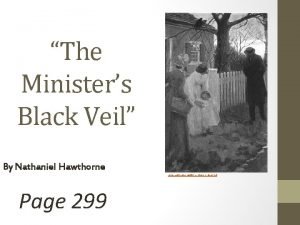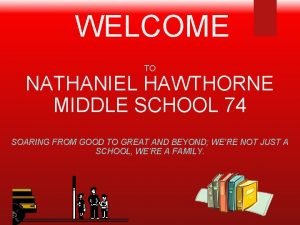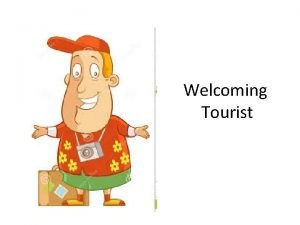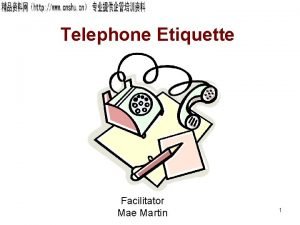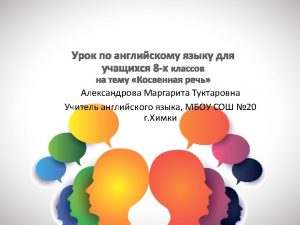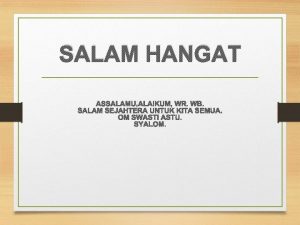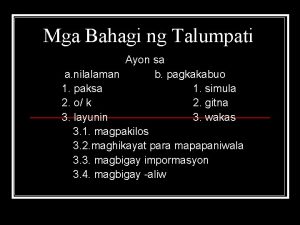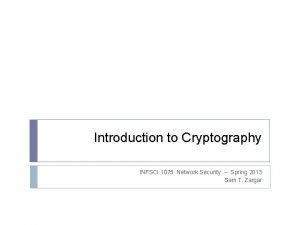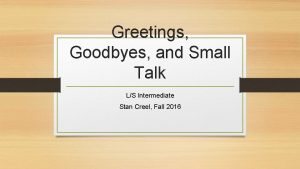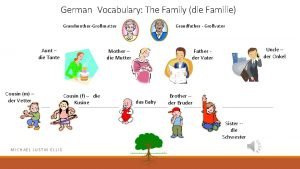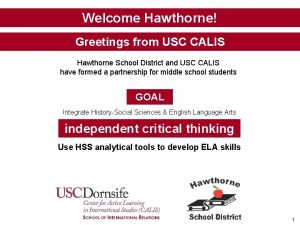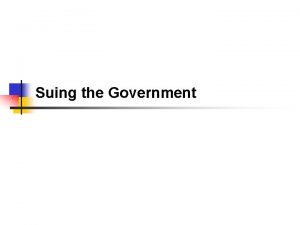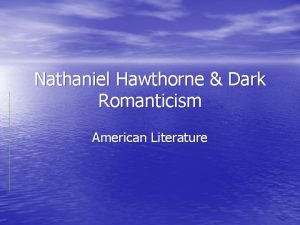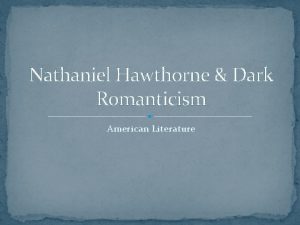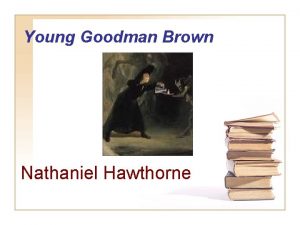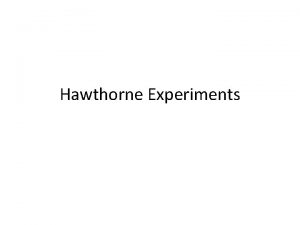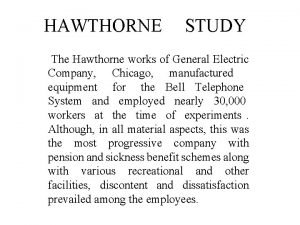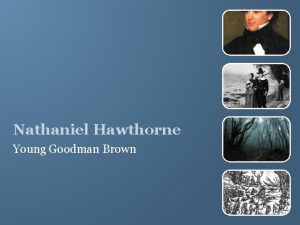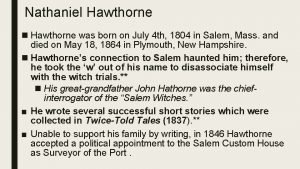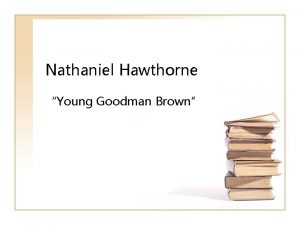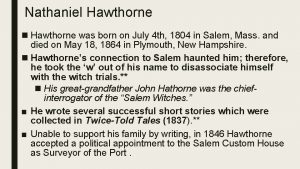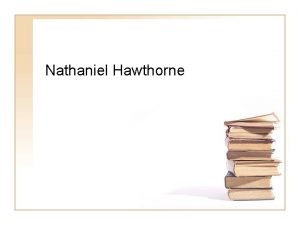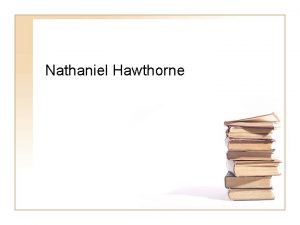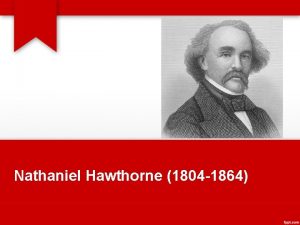Welcome Hawthorne Greetings from USC CALIS Hawthorne School

























- Slides: 25

Welcome Hawthorne! Greetings from USC CALIS Hawthorne School District and USC CALIS have formed a partnership for middle school students GOAL Integrate History-Social Sciences & English Language Arts independent critical thinking Use HSS analytical tools to develop ELA skills 1

Independent Critical Thinking Input listening reading INPUT Output speaking writing active reading & active listening = be able to infer & relate concepts/ideas (factors, virtues, etc. ) = be able to think critically about information/ideas OUTPUT clear, cohesive speaking & writing = be able to further synthesize, evaluate information/ideas = be able to express critical thinking 2

Independent Critical Thinking Once you are equipped to be a critically thinking listener and reader, then you are equipped to be an articulate speaker and writer. As your understanding of history deepens, your skills in language arts will grow. The art of teaching is the art of assisting discovery. Mark Van Doren USC CALIS │ School of International Relations (IR) 3

Social Sciences & Language Arts Integration 6 th Grade Ancient World History Mesopotamia: The Rise of Sumerian City-States Inquiry Arc � Focus Question How were the first small villages able to transition to large settlements and develop into urban centers? � Culminating Writing Prompt Or: What was the agricultural revolution and what was its effect on human history? Or: Trace the impact of technology that provided a turning point in human history from villages to the first city-states. ? 4

Four Worlds of… Water How is water part of each world? Political World How is government involved with water? Social World How is water a class issue? Economic World What kinds of products & services involve water? water Cultural World Does water have special meaning for some people or special uses? 5

Which factors can be related to this image? Political World Economic World managing the commons public goods production natural resources infrastructure innovation & efficiency water Social World lack of equity Cultural World religion identity & access practices rites & rituals 6

How are the Four Worlds present in the feature film story of Antz? Political World Social World Economic World Cultural World 7

s! world r u o f n i e I liv Political World Social World Each world has different influences on me and I have a role & influence in each world, too! Economic World Cultural World 8

4 W Inventory – Factor Review Using three different colors, highlight the factors on the factor sheet that were idenitified for each 4 W exercise water Antz me 9

Enduring Dynamics #1 What is the connection between a society's form of government and its beliefs, ideas, and expectations? 4 W factors Political World Economic World type of government Social World Cultural World beliefs ideas expectations 10

Enduring Dynamics #1 Inference Exercise: Identify factors and trace dynamics “The Sumerians believed that their kings were chosen by the gods to rule in their place. This belief made their kings very powerful. It also helped strengthen the social order, since Sumerians believed they must obey the will of the gods. ” Political World Social World 4 W analysis Economic World Proceed to Step 1. Quote from History Alive! The Ancient World, TCI, 2004 ― Chapter 5: Was Ancient Sumer a Civilization? – page 45 Cultural World 11

Enduring Dynamics #1 Inference Exercise: Identify factors and trace dynamics 4 W analysis “The Sumerians believed that their kings were chosen by the gods to rule in their place. This belief made their kings very powerful. It also helped strengthen the social order, since Sumerians believed they must obey the will of of the gods. ” Political World Economic World kings powerful order 1 Social World Place each highlighted term in the world where it belongs. Cultural World beliefs chosen by the gods must obey the will of the gods Quote from History Alive! The Ancient World, TCI, 2004 ― Chapter 5: Was Ancient Sumer a Civilization? – page 45 12

Enduring Dynamics #1 Inference Exercise: Identify factors and trace dynamics 4 W analysis “The Sumerians believed that their kings were chosen by the gods to rule in their place. This belief made their kings very powerful. It also helped strengthen the social order, since Sumerians believed they must obey the will of of the gods. ” Political World Economic World kings powerful order 2 Social World After organizing highlighted terms, identify 4 W factors. Cultural World beliefs chosen by the gods must obey the will of the gods Quote from History Alive! The Ancient World, TCI, 2004 ― Chapter 5: Was Ancient Sumer a Civilization? – page 45 13

Enduring Dynamics #1 Inference Exercise: Identify factors and trace dynamics 4 W analysis “The Sumerians believed that their kings were chosen by the gods to rule in their place. This belief made their kings very powerful. It also helped strengthen the social order, since Sumerians believed they must obey the will of of the gods. ” Political World Economic World type of government monarchy kings powerful order 3 Social World Add a factor. Which type of government has a king? Cultural World beliefs chosen by the gods must obey the will of the gods Quote from History Alive! The Ancient World, TCI, 2004 ― Chapter 5: Was Ancient Sumer a Civilization? – page 45 14

Enduring Dynamics #1 Inference Exercise: Identify factors and trace dynamics 4 W analysis “The Sumerians believed that their kings were chosen by the gods to rule in their place. This belief made their kings very powerful. It also helped strengthen the social order, since Sumerians believed they must obey the will of of the gods. ” Political World Economic World type of government monarchy kings powerful order 4 Social World What is the direction of the relationship (an arrow) between the factors in these two worlds? Cultural World beliefs chosen by the gods must obey the will of the gods Quote from History Alive! The Ancient World, TCI, 2004 ― Chapter 5: Was Ancient Sumer a Civilization? – page 45 15

Enduring Dynamics #1 Inference Exercise: Identify factors and trace dynamics 4 W analysis “The Sumerians believed that their kings were chosen by the gods to rule in their place. This belief made their kings very powerful. It also helped strengthen the social order, since Sumerians believed they must obey the will of of the gods. ” Political World Economic World type of government monarchy kings powerful 5 Label the arrow! What is the relationship? What is the verb for this relationship? order legitimate authority Social World Cultural World Beliefs support the type of government. What is the special term for this belief? Is there a factor for this relationship? beliefs divine right chosen by the gods must obey the will of the gods Quote from History Alive! The Ancient World, TCI, 2004 ― Chapter 5: Was Ancient Sumer a Civilization? – page 45 16

Enduring Dynamics #1 Inference Exercise: Identify factors and trace dynamics 4 W analysis “The Sumerians believed that their kings were chosen by the gods to rule in their place. This belief made their kings very powerful. It also helped strengthen the social order, since Sumerians believed they must obey the will of of the gods. ” Political World Economic World type of government monarchy kings powerful order legitimate authority Social World Cultural World Beliefs support the type of government. 6 What is the significance? Our beliefs about who has authority over our lives will determine the type of government that has the right to rule over our society. beliefs divine right chosen by the gods must obey the will of the gods Quote from History Alive! The Ancient World, TCI, 2004 ― Chapter 5: Was Ancient Sumer a Civilization? – page 45 17

Enduring Dynamics #1 What is the connection between a society's form of government and its beliefs, ideas, and expectations? 4 W factors Political World Economic World monarchy In the Western World, the belief in divine right lasted for over 5, 000 years till the Enlightenment. type of government kings legitimate authority Social World Cultural World Beliefs support the type of government. divine right Our beliefs about who has authority over our lives will determine the type of government that has the right to rule over our society. beliefs ideas expectations 18

Independent Critical Thinking Input listening reading Output speaking writing INPUT ! w o active reading & active u listening n k OUTPUT clear, cohesive speaking & writing o y t a h = be able to w inferw & relate concepts/ideas (factors, virtues, etc. ) o Sh = be able to think critically about information/ideas = be able to further synthesize, evaluate information/ideas = be able to express critical thinking 19

Inspired by 90 seconds to prepare in pairs, then… Pass the mic Explain the importance of divine right. 20

Inspired by For teachers: 90 seconds to prepare in pairs, then… Pass the mic A parent sees you in the parking lot and wants to ask a quick question… What’s the four worlds thing my child is talking about? For students: You’re at a family gathering and your mom is telling your aunt about your history class being supported by USC. She asks you… Tell her about the four worlds thing. 21

Social Sciences & Language Arts Integration GOAL: independent critical thinking “Not knowing an answer is very uncomfortable. The process of good reasoning requires us to delay landing on an answer. It requires us to doubt any preconceived ideas and seek for why an answer might be wrong. [Students] must delay an answer. In order for students to deeply reason, they must sustain doubt. They must learn to enjoy the muddle of looking for holes in a theory. If we want students to reason deeply we must make this process of reasoning the main point of academics. ” That's Why: Examining Reasoning and Justification Catherine Underwood and Kathryn Gullo Both are National Board Certified Teachers and UCLA Writing Project Fellows in LAUSD. California English, Vol 20. 4, April-May 2015 22

Social Sciences & Language Arts Integration Best Practices Best way to become a better reader… Read more. Best way to become a better writer… Write more. Best way to develop critical thinking is through critical thinking 23

Four Worlds │ 4 W Analysis a project of the Center for Active Learning in International Studies School of International Relations UNIVERSITY OF SOUTHERN CALIFORNIA Four Worlds of Social Science Factors Teresa Hudock, Director, USC CALIS is based on the Four Worlds of International Relations Steven Lamy, Professor, School of IR Classroom materials are available free online at dornsife. usc. edu/calis For more information, contact: Teresa Hudock calis@usc. edu 213 -740 -7794 24

Four Worlds │ 4 W analysis Attention all recipients of this file: First, thank you for opening this powerpoint and considering using it! Whether the file was sent to you directly from Teresa or relayed by a colleague, CALIS and USC rely on your professionalism for proper credits and sourcing: Materials developed by or through CALIS are made available online via a database and website that serve as a digital file cabinet of teaching resources. Materials are free in support of teachers and students, and to promote curriculum reform. When teachers or other CALIS partners write, adapt, or collaborate on materials —they are cited. The source information includes their affiliated schools or organizations. As others download and further adapt these materials—all credit and source lines, for teachers as well of for USC CALIS, should remain in tact as the original source. This ppt was created as part of a partnership with Hawthorne School District, Year 2: 2017 -2018. The ppt initially supported a packet of materials reviewed with teachers in August 2017. Hawthorne School District Instructional Leadership Team for Integrating History-Social Science and English Language Arts Initial Launch: Aug 15, 2017 This Edition: Aug 23, 2017 Teresa Hudock, Director, USC CALIS 213 -740 -7794 or calis@usc. edu dornsife. usc. edu/calis 25
 Crabby calis
Crabby calis Nathaniel hawthorne middle school 74
Nathaniel hawthorne middle school 74 Wise men three clever are we
Wise men three clever are we Tour guide greetings
Tour guide greetings Good morning ladies and gents
Good morning ladies and gents Many greetings from
Many greetings from Short voicemail greetings personal
Short voicemail greetings personal Afternoon greetings for speech
Afternoon greetings for speech With warmest regards
With warmest regards Ladies and gentlemen presentation
Ladies and gentlemen presentation Talumpati parts
Talumpati parts Dear george greetings to all at oxford
Dear george greetings to all at oxford The layout of an informal letter
The layout of an informal letter Hello how are you what are you doing now
Hello how are you what are you doing now Good morning
Good morning Greetings farewells and small talk
Greetings farewells and small talk Tom hello good morning hello good
Tom hello good morning hello good Grüβ gott
Grüβ gott Kinds of greetings
Kinds of greetings Greetings from our lord jesus christ
Greetings from our lord jesus christ Good morning students good
Good morning students good German family vocabulary
German family vocabulary French greetings formal and informal
French greetings formal and informal French phrases greetings
French phrases greetings Greeting and leave taking conversation
Greeting and leave taking conversation Armenian happy easter
Armenian happy easter
